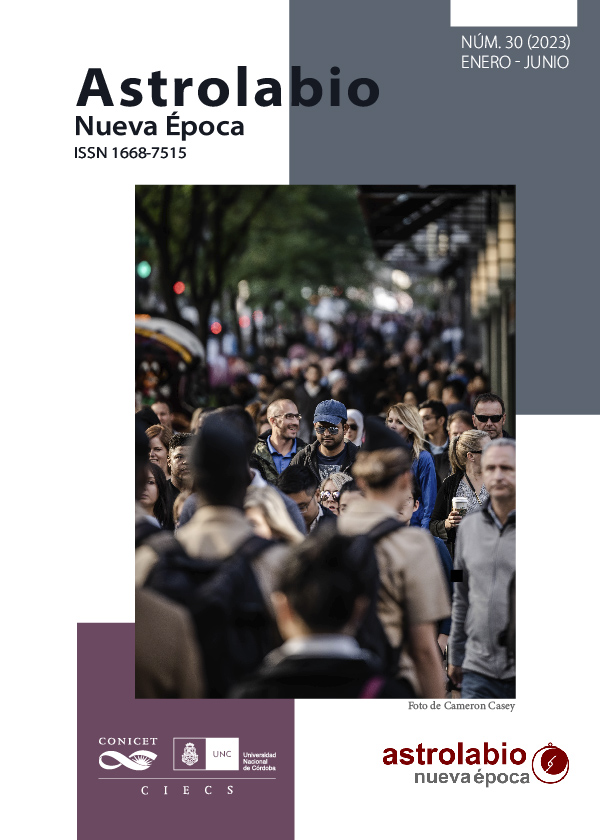Analysis of internal migrations in Argentina in the period 2005-2010
Main Article Content
Abstract
- In this article, factors associated with the internal migrations of Argentina are analyzed. A theoretical discussion of the different migratory perspectives is presented, distinguishing between individual-economic and structural-social approaches. Using the migration matrix for the 24 districts, obtained with Redatam corresponding to census 2010, migration indicators (gross and net migration rates, and migration efficiency index, among others) were calculated. A script was also developed to make new circular diagrams that visually summarize migratory flows, constituting a colorful and useful instrument to have a more complete and faster panorama than the traditional matrix. The main migratory flows between provinces were identified. Net migration rates were positive in Patagonia, negative in northern Argentina and notably in Buenos Aires City (CABA). In the Pampeana region, flows are high and migration rates were lower. Subsequently, a more detailed analysis was carried out using the Annual Survey of Urban Households of the same year, which has data at the individual level and additional variables to carry out a more in-depth analysis. Attraction and expulsion factors were identified, among the main conclusions income is an important factor for attracting migrants, as indicated by neoclassical theory, but sociodemographic factors such as education were also considered. In general, migrations are associated with higher incomes, but also higher unemployment rates, which may be due to difficulties in finding employment in the new destination.
Downloads
Article Details

This work is licensed under a Creative Commons Attribution-NonCommercial-ShareAlike 4.0 International License.
Astrolabio, Nueva Época está protegida bajo licencia Licencia Creative Commons Atribución-NoComercial-CompartirIgual 4.0 Internacional. La propiedad intelectual de los artículos pertenece a los autores y los derechos de edición y publicación a la revista. Los artículos publicados podrán ser usados libremente para propósitos científicos y académicos, siempre y cuando se realice una correcta citación de los mismos. Cualquier persona física o jurídica que desee reimprimir parte o la totalidad de algún artículo, deberá obtener permiso escrito de los editores de Astrolabio Nueva Época, quien lo otorgará con el consentimiento del autor.
References
BELL, Martin y MUHIDIN, Salut. (2009). Cross-national Comparisons of Internal Migration. New York: UNDP.
BORJAS, George. (1987). “Self-Selection and the Earnings of Immigrants”. American Economic Review, 77-4, 531-553.
BORJAS, George; BRONARS, Stephen; y TREJO, Stephen. (1992). “Self-selection and Internal Migration in the United States”. Journal of Urban Economics, 32-2, 159-185.
BUSSO, Gustavo. (2007). “Migración interna y desarrollo territorial en Argentina a inicios del Siglo XXI. Brechas e impactos sociodemográficos de la migración interna interprovincial”. Ponencia presentada en las IX Jornadas Argentinas de Estudios de Población. Huerta Grande, Córdoba, 31 de octubre al 2 de noviembre.
CLARK, Ximena; HATTON, Timothy J.; y WILLIAMSON, Jeffrey G. (2003). What Explains Cross Border Migration in Latin America? Cambridge, Massachusetts: Harvard Institute of Economic Research. Recuperado de: https://papers.ssrn.com/sol3/papers.cfm?abstract_id=431701 [consulta: 29 de enero de 2021].
FAURA MARTÍNEZ, Úrsula y GÓMEZ GARCÍA, Juan. (2002). “¿Cómo medir los flujos migratorios?”. Papers, Revista de Sociología, 66, 15-44.
HAAS, Hein de. (2010). “Migration and Development: A Theoretical Perspective”. International Migration Review, 44-1, 227-264.
HARRIS, John R. y TODARO, Michael P. (1970). “Migration, Unemployment and Development: a Two-sector Analysis”. The American Economic Review, 60-1, 126-142.
INDEC (INSTITUTO NACIONAL DE ESTADÍSTICAS Y CENSOS). (2003). ¿Qué es el Gran Buenos Aires? Ciudad Autónoma de Buenos Aires: Autor.
INDEC (INSTITUTO NACIONAL DE ESTADÍSTICAS Y CENSOS). (2010). Encuesta anual de hogares urbanos. Diseño de registro y estructura para las bases de microdatos. Ciudad Autónoma de Buenos Aires: Autor.
INDEC (INSTITUTO NACIONAL DE ESTADÍSTICAS Y CENSOS). (2011). Encuesta permanente de hogares. Conceptos de condición de actividad, subocupación horaria y categoría ocupacional. Ciudad Autónoma de Buenos Aires: Autor.
INDEC (INSTITUTO NACIONAL DE ESTADÍSTICAS Y CENSOS). (2012). Censo nacional de población, hogares y viviendas 2010. Censo del Bicentenario. Ciudad Autónoma de Buenos Aires: Autor.
KEUNTAE, Kim y COHEN, Joel E. (2010). “Determinants of International Migration Flows to and from Industrialized Countries: A Panel Data Approach Beyond Gravity”. International Migration Review, 44-4, 899-932.
LACOMBA, Joan. (2001). “Teorías y prácticas de la inmigración de los modelos explicativos a los relatos y proyectos migratorios”. Scripta Nova. Revista Electrónica de Geografía y Ciencias Sociales, 94-11, sin paginación. Recuperado de: http://www.ub.edu/geocrit/sn-94-3.htm [consulta: 27 de enero de 2021].
MASSEY, Douglas S.; ARANGO, Joaquín; HUGO, Graeme; KOUAOUCI, Ali; PELLEGRINO, Adela; y TAYLOR, J. Edward. (1993). “Theories of International Migration: a Review and Appraisal”. Population and Development Review, 19-3, 431-466.
MOLLOY, Raven; SMITH, Christopher L.; y WOZNIAK, Abigail. (2011). “Internal Migration in the United States”. Journal of Economic Perspectives, 25-3, 173-96.
PARIKH, Ashok y VAN LEUVENSTEIJN, Michiel. (2002). Internal Migration in Regions of Germany: A Panel Data Analysis. Brussels: ENEPRI-CEPS.
PARIKH, Ashok y VAN LEUVENSTEIJN, Michiel. (2003). “Interregional labour mobility, inequality and wage convergence”. Applied Economics, 35-8, 931-941.
PINTO DA CUNHA, José Marcos y BAENINGER, Rosana. (2007). “Las migraciones internas en el Brasil contemporáneo”. Notas de Población, 32-82, 33-67.
R CORE TEAM. (2021). R: A language and environment for statistical computing. R Vienna: Foundation for Statistical Computing.
RAVENSTEIN, Ernst G. (1885). “The Laws of Migration”. Journal of the Statistical Society of London, 48-2, 167-235.
RAVENSTEIN, Ernst G. (1889). “The Laws of Migration”. Journal of the Royal Statistical Society, 52-2, 241-305.
RODRÍGUEZ VIGNOLI, Jorge. (2017). “Efectos de la migración interna sobre el sistema de asentamientos humanos de América Latina”. Revista de la CEPAL, 123, 7-34.
RODRÍGUEZ VIGNOLI, Jorge. (2019). “Migraciones internas en Chile, 1977-2017: continuidad y cambio”. Santiago: CEPAL.
SANDER, Nikola; ABEL, Guy J.; BAUER, Ramon; y SCHMIDT, Johannes. (2014). Visualising Migration Flow Data with Circular Plots. Vienna: Vienna Institute of Demography. Recuperado de: https://epub.oeaw.ac.at/0xc1aa5576%200x003d0699.pdf [consulta: 27 de enero de 2021].
WOOD, Charles H. (1982). “Equilibrium and Historical Structural Perspectives on Migration”. International Migration Review, 16-2, 298-319.
ZELINSKY, Wilbur. (1971). “The Hypothesis of the Mobility Transition”. Geographical Review, 61-2, 219-249.
ZHAO, Zhong. (2004). “Rural-Urban Migration in China – What Do We Know and What Do We Need to Know?”. China Economic Quarterly, 3-3, 517-536.

